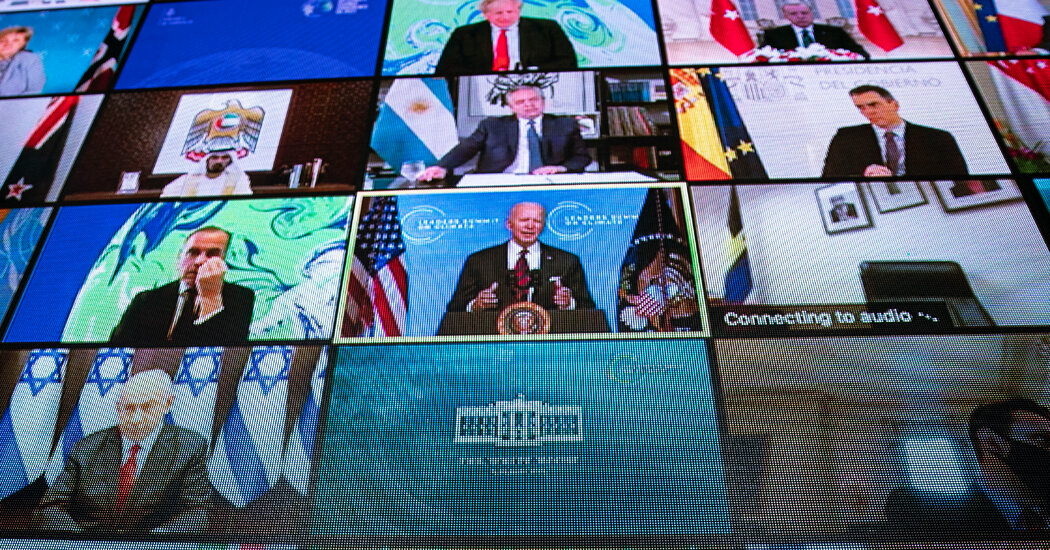
So yes, that White House global summit happened.
President Biden used the occasion to announce that his administration would seek to rapidly reduce the planet-warming emissions that the United States pumps into the atmosphere and would spend a ton of money to transform the American economy from one that relies heavily on fossil fuels to one that is more green. The goal was to convey to the rest of the world that America is doing is part, and everyone else should also step up and address climate change.
“Now comes the hard part,” as I wrote Friday at the conclusion of the summit. The White House has a tough to-do list if it wants to be a global climate leader.
It has to persuade Congress to pour money into its climate plan, not just for building green infrastructure at home, but also for grants and loans it says it will offer to poor countries around the world to adapt to the effects of warming. Without serious money and rapid emissions reductions at home, analysts noted, the United States is likely to have a hard time persuading recalcitrant governments hooked on coal, oil and gas.
The biggest diplomatic test for the administration is how to deal with its main rival on the world stage: China, which currently produces the largest share of global greenhouse gas emissions, while the United States is responsible for the largest share of emissions since the start of the industrial era.
How the United States deals with China on climate change in the coming months will, to a large degree, determine whether the world can avert the worst effects of warming. That’s the real summit that both countries need to scale up their efforts.
Listen: Our colleague Coral Davenport talks about the summit, the Zoom glitches and what’s next on The Daily.
Charts: See how President Biden’s pledge to cut emissions stacks up against other countries’ plans.
A vision of the future: Hitting the U.S. goals would mean a very different America: Electric cars, expanded forests and complex new carbon-capture technology.
We want to hear from you!
Have you or someone you know tried to get help from FEMA after a disaster? We want to hear about your experience — good, bad or in between. You can share it with us by emailing climateteam@nytimes.com. Please include your name and contact information.
Climate change will be costly. Ignoring it will be, too.
Rising temperatures are likely to reduce global wealth significantly by 2050, a major insurance company warned last week, as crop yields fall, disease spreads and rising seas consume coastal cities.
The company, by Swiss Re, warned of particularly devastating consequences for some large countries in Asia, whose economic output could be one-third lower than in a world without climate change.
The numbers: An increase of 2.6 degrees Celsius above preindustrial levels could shave 14 percent off global economic output in 2050, the report found. That’s the equivalent of $23 trillion in lost wealth.
Late night comedy: Get Stephen Colbert’s take on the story.
About that other greenhouse gas …
Carbon dioxide has always been considered the main culprit of global warming. And while reducing carbon dioxide emissions remains the absolute priority, a growing chorus of voices within the science and environmental communities has called attention to the warming caused by methane, another potent greenhouse gas.
Now, a major United Nations report is set to declare that reducing emissions of methane, the main component of natural gas, is far more important than previously thought. You can read the article here.
Quotable: While cutting back on carbon dioxide emissions will remain urgent, “it’s going to be next to impossible to remove enough carbon dioxide to get any real benefits for the climate in the first half of the century,” said Drew Shindell, the study’s lead author and a professor of earth science at Duke University. “But if we can make a big enough cut in methane in the next decade, we’ll see public health benefits within the decade, and climate benefits within two decades.”
Scientists usually set up their own experiments, either in a laboratory or out in the world. But occasionally the world sets up an experiment for them, enabling them to gain insight they might not have gained otherwise.
That was the case after the terrorist attacks of Sept. 11, 2001, when the grounding of all commercial airline flights for several days gave researchers the chance to study the climate impact of vapor trails from aircraft.
And it’s the case now, during the pandemic, as stay-home orders have sharply cut pollution. As I wrote this week, researchers reported that lockdown-related cleaner skies over the Indus River basin in India and Pakistan significantly slowed snowmelt, with potential benefits, at least temporarily, for the 300 million people who depend on the river for water.
Scientists know that pollutants, especially soot, that land on snow can cause it to melt faster, and it follows that less soot can slow melting. But without this real-world experiment, would researchers have realized the extent to which clearer air can affect water supplies? And are there other positive benefits of cleaning up the environment that are yet to be uncovered?
If you’re not getting Climate Fwd: in your inbox, you can sign up here
We’d love your feedback on the newsletter. We read every message, and reply to many! Please email thoughts and suggestions to climateteam@nytimes.com.


Average Rating